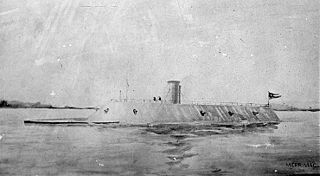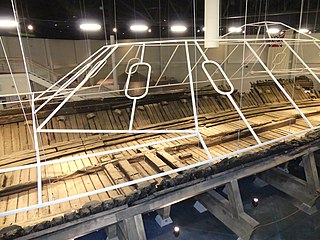
CSS Virginia was the first steam-powered ironclad warship built by the Confederate States Navy during the first year of the American Civil War; she was constructed as a casemate ironclad using the razéed original lower hull and engines of the scuttled steam frigate USS Merrimack. Virginia was one of the participants in the Battle of Hampton Roads, opposing the Union's USS Monitor in March 1862. The battle is chiefly significant in naval history as the first battle between ironclads.
CSS Scorpion was a Squib-class torpedo boat that served in the Confederate States Navy during the American Civil War. Armed with a single spar torpedo, she originally served guard duty on the James River after being built in late 1864. Along with the rest of the James River Squadron, Scorpion moved downriver on January 23, 1865, and participated in the Battle of Trent's Reach. After performing depth soundings near Union obstructions, Scorpion moved to get a lantern from the ironclad CSS Virginia II, but ran into a hawser and then ran aground. At 07:10 on the morning of January 24, Union fire struck the abandoned tender CSS Drewry, which then exploded. The force of the explosion swept Scorpion out of control downriver. An attempt to rescue her that night failed, and she was captured by Union forces.

CSS Texas was the third and last Columbia-class casemate ironclad built for the Confederate Navy during the American Civil War. Not begun until 1864 and intended to become part of the James River Squadron, she saw no action before being captured by Union forces while still fitting out. CSS Texas was reputed to have been one of the very best-constructed Confederate ironclads, second only to CSS Mississippi.

CSS Albemarle was a steam-powered casemate ironclad ram of the Confederate Navy, named for an estuary in North Carolina which was named for General George Monck, the first Duke of Albemarle and one of the original Carolina Lords Proprietor.

The Battle of Hampton Roads, also referred to as the Battle of the Monitor and Merrimack or the Battle of Ironclads, was a naval battle during the American Civil War.

USS Galena was a wooden-hulled broadside ironclad built for the United States Navy during the American Civil War. The ship was initially assigned to the North Atlantic Blockading Squadron and supported Union forces during the Peninsula Campaign in 1862. She was damaged during the Battle of Drewry's Bluff because her armor was too thin to prevent Confederate shots from penetrating. Widely regarded as a failure, Galena was reconstructed without most of her armor in 1863 and transferred to the West Gulf Blockading Squadron in 1864. The ship participated in the Battle of Mobile Bay and the subsequent Siege of Fort Morgan in August. She was briefly transferred to the East Gulf Blockading Squadron in September before she was sent to Philadelphia, Pennsylvania for repairs in November.

Atlanta was a casemate ironclad that served in the Confederate and Union Navies during the American Civil War. She was converted from a British-built blockade runner named Fingal by the Confederacy after she made one run to Savannah, Georgia. After several failed attempts to attack Union blockaders, the ship was captured by two Union monitors in 1863 when she ran aground. Atlanta was floated off, repaired, and rearmed, serving in the Union Navy for the rest of the war. She spent most of her time deployed on the James River supporting Union forces there. The ship was decommissioned in 1865 and placed in reserve. Several years after the end of the war, Atlanta was sold to Haiti, but was lost at sea in December 1869 on her delivery voyage.

USS Onondaga was an ironclad river monitor built for the Union Navy during the American Civil War. Commissioned in 1864, the ship spent her entire active career with the James River Flotilla covering the water approaches to the Confederate States capital of Richmond, Virginia, although her only notable engagement was the Battle of Trent's Reach. After the war, she was purchased by France where she served as a coastal defense ship in the French Navy.
CSS North Carolina was a casemate ironclad built for the Confederate Navy in 1863 during the American Civil War by Berry & Brothers at Wilmington, North Carolina at a cost of $76,000. She was placed in commission during the latter part of the year with Commander W. T. Muse, CSN, in command.

CSS Manassas, formerly the steam icebreaker Enoch Train, was built in 1855 by James O. Curtis as a twin-screw towboat at Medford, Massachusetts. A New Orleans commission merchant, Captain John A. Stevenson, acquired her for use as a privateer after she was captured by another privateer CSS Ivy. Her fitting out as Manassas was completed at Algiers, Louisiana; her conversion to a ram of a radically modern design made her the first ironclad ship built for the Confederacy.

CSS Richmond was the name ship of her class of six casemate ironclads built for the Confederate States Navy during the American Civil War. Completed during 1862 the ship was assigned to the James River Squadron where she mostly supported Confederate forces near Richmond, Virginia. She was burned in April 1865 to prevent her capture by Union forces.
CSS Raleigh was a steam-powered Civil War casemate ironclad. She was fitted with a spar torpedo instead of an iron ram and was built in 1863–1864 by the Confederate States Navy at Wilmington, North Carolina. While she was being built her commander was Lieutenant John Wilkinson (CSN). She was put into commission on April 30, 1864 under the command of Lieutenant J. Pembroke Jones, CSN.
The CSS Beaufort was an iron-hull gunboat that served in North Carolina and Virginia during the American Civil War. Originally launched as Caledonia at Wilmington, Delaware, in 1854, the ship was owned by James Cathcart Johnston. It saw use as a tugboat on the Dismal Swamp Canal. On July 9, 1861, Beaufort was commissioned into the navy of the state of North Carolina for use in the American Civil War. First serving on the North Carolina coast, Beaufort was present at the battles of Roanoke Island and Elizabeth City in February 1862. Escaping the Confederate defeat at Elizabeth City via the Dismal Swamp Canal, Beaufort reached Norfolk, Virginia, where she joined the James River Squadron.

CSS Fredericksburg was a casemate ironclad that served as part of the James River Squadron of the Confederate States Navy during the American Civil War. Laid down in 1862 and Launched the following year, she did not see action until 1864 due to delays in receiving her armor and guns. After passing through the obstructions at Drewry's Bluff in May 1864, she participated in several minor actions on the James River and fought in the Battle of Chaffin's Farm from September 29 to October 1. On January 23 and 24, 1865, she was part of the Confederate fleet at the Battle of Trent's Reach, and was one of only two Confederate ships to make it past the obstructions at Trent's Reach. After the Confederate attack failed, Fredericksburg withdrew with the rest of the James River Squadron. On April 3, as the Confederates were abandoning Richmond, Fredericksburg and the other vessels of the James River Squadron were burned. Her wreck was located in the 1980s, buried under sediment.

William Augustin Webb was an American sailor and Mexican–American War veteran who resigned his United States Navy commission after more than 20 years of service to join the Confederate States Navy in the American Civil War. Webb was decorated for his service as Captain of the CSS Teaser, part of the James River Squadron, during the Battle of Hampton Roads (1862).
The James River Squadron was formed shortly after the secession of Virginia during the American Civil War. The squadron was part of the Virginia Navy before being transferred to the Confederate States Navy. The squadron is most notable for its role in patrolling the James River, which was the main water approach to the Confederate capital, Richmond. It had two phases: early war, when it consisted mostly of wooden ships which ended with the Battle of Drewry's Bluff on May 15, 1862; and its later ironclad composition with the flagship CSS Virginia II.

The casemate ironclad was a type of iron or iron-armored gunboat briefly used in the American Civil War by both the Confederate States Navy and the Union Navy. Unlike a monitor-type ironclad which carried its armament encased in a separate armored gun deck/turret, it exhibited a single casemate structure, or armored citadel, on the main deck housing the entire gun battery. As the guns were carried on the top of the ship yet still fired through fixed gunports, the casemate ironclad is seen as an intermediate stage between the traditional broadside frigate and modern warships.

CSS Neuse was a steam-powered ironclad ram of the Confederate States Navy that served in the latter part the American Civil War and was eventually scuttled in the Neuse River to avoid capture by rapidly advancing Union Army forces. In the early 1960s, she produced approximately 15,000 artifacts from her raised lower hull, the largest number ever found on a recovered Confederate vessel. The remains of her lower hull and a selection of her artifacts are on exhibit in Kinston, North Carolina at the CSS Museum, which belongs to the North Carolina Department of Natural and Cultural Resources. The ironclad is listed on the National Register of Historic Places.

The Battle of Trent's Reach was one of the final major naval battles of the American Civil War. Beginning on January 23, 1865, a powerful flotilla of Confederate warships bombarded Fort Brady along the James River and engaged four Union Navy ships with the intention of breaking through the blockade to attack City Point, the base of General Ulysses S. Grant who was besieging Petersburg, Virginia. After two days of fighting, the rebels withdrew back up the river without completing their objectives.

The Squib class torpedo boats were built for the Confederate States Navy during the later stages of the American Civil War. After the torpedo boat CSS David attacked and damaged the ironclad USS New Ironsides, the Confederates continued building torpedo boats with hopes of breaking the Union blockade. Four vessels of the class – CSS Hornet, CSS Wasp, CSS Squib, and CSS Scorpion – were constructed in Richmond, Virginia, in 1864. All were armed with a single spar torpedo and were powered by steam engines. Squib damaged the gunboat USS Minnesota in an attack on April 9, 1864, and was later sent to Wilmington, North Carolina, where she was scuttled in February 1865. The other three vessels of the class were all part of the James River Squadron and participated in the Battle of Trent's Reach on the night of January 23 and 24, 1865. Scorpion ran aground during the battle, and was forced downriver and out of control after the tender CSS Drewry exploded on January 24. She was later captured by Union forces and may have been burned. Hornet was sunk in a collision with another vessel on January 27, and Wasp was scuttled on the night of April 2/3, as the Confederates were abandoning Richmond.

















